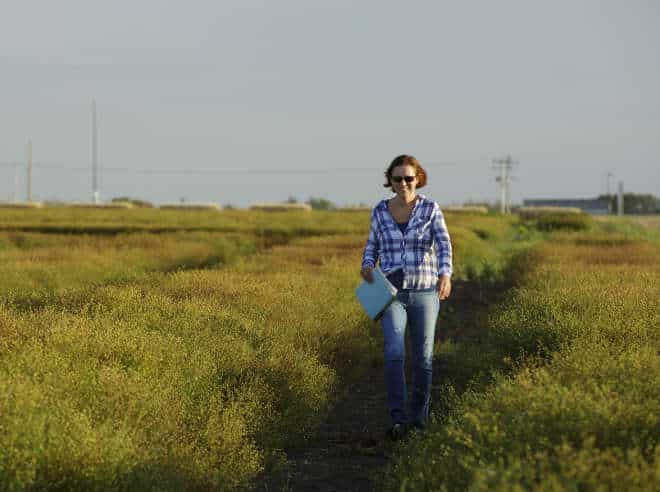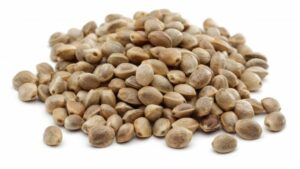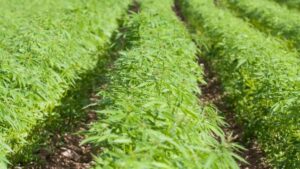Breeding efforts related to fibre content of flax and hemp are going in separate directions, and hemp breeding for fibre may take an interesting turn.
First, an update on flax, which is grown by Canadian farmers because it provides a decent profit and because its inclusion in the rotation also offers control of disease and insect populations that commonly afflict other oilseed crops (and cereals): acreage on the Canadian Prairies varies from 400,000 to 800,000 hectares or one to two million acres.
“There are three oilseed flax varieties commonly grown in Canada, all medium-tall with most offshoots at the top, and all do well under our growing conditions,” says Dr. Helen Booker, an associate professor and flax breeder at the University of Saskatchewan in Saskatoon. “CDC Bethune was registered in 1998 and it’s still popular. CDC Sorell was registered in 2005, and the newest variety is CDC Glas, first available in 2014.” These cultivars respectively made up 25, 21 and 17 per cent of the total acreage in 2017, respectively.
However, many farmers are hesitant to grow flax because the straw is troublesome. It’s not easy to chop and spread it and it decomposes very slowly. The straw can be burned or baled and sold, but buyers need bales to be clean of debris. According to the new Flax Grower’s Guide produced by the Flax Council of Canada and its partners, Schweitzer-Mauduit Canada of Winkler, Man. is the largest Canadian flax straw processor. Smaller buyers/processors include Biolin Processing near Elstow, Sask., a pilot facility operated by Innotech Alberta in Vegreville, Alta., Synermulch in Calgary, Erosion Control Blanket in Riverton, Man. and Urban Forest Recyclers in Swift Current, Sask.
Indeed, there have never been more uses for flax straw. “Flax straw is being used for animal bedding, duck nesting, linage for drainage ditches and construction of straw bale buildings, windbreaks and other shelters,” Booker says. “The bales are also burned to provide heat and the straw is used to cover golf course greens, insulate in trailer homes, make mulch for pathways, and to make cigarette papers, bio-fuel, composites and textiles.”
However, Booker says a recent survey done by the Saskatchewan Flax Development Commission (SaskFlax) confirmed that many farmers are just not interested in growing flax because of the straw management issues. SaskFlax has approached Booker to look into the possibility of developing a variety with reduced straw strength (thereby reducing bast fibre content).

“It would be preferable to have a market for the straw, but if that’s not in the cards, then the next step is to minimize the burden of managing the straw,” Booker explains. However, she notes that development of a variety that still includes the needed agronomic qualities but has less straw strength is a large undertaking. For starters, it would involve working with a breeding company in France to measure differences in straw strength of various varieties.
“The differences may be subtle,” Booker explains. “We also must look at how straw strength is related to agronomic traits like lodging resistance — we can’t reduce straw strength too much. We also have to see how much straw strength differences are due to growing conditions year to year. There is also the thinking that we need to improve quality of the straw through management, for example minimizing damage to the straw by cutting or stripping only heads off plants, mowing or rolling standing straw after the seed is harvested, and allowing retting and use a V-rake to rake straw in windrows and balers to make large round bales of straw.”
Booker says there have been similar flax breeding projects in the past, and that “we’ll see what happens this time.”
Hemp Goes its Own Way
Breeding goals with regard to fibre are currently very different for hemp, notes Jan Slaski, the team lead of crop development and management at Innotech Alberta who has expertise with hemp going back to its introduction in Canada. Slaski says that up until a year ago, most hemp in Canada was grown for oilseed, but demand is now growing for the fibre and another emerging cutting-edge use (more on that later).
“In 2017, there were 55,000 hectares licenced in Canada, which is a staggering increase of more than 20,000 acres over 2016,” Slaski notes. “What’s bringing in the new growers is a really good profit, way better than other crops. And part of that is because we have a growing fibre market now.”
Indeed, the long-fibre material found on the outside of the stalks is now in demand for textiles, paper, bio-composites and more. “Seven years ago here in Vegreville,” says Slaski, “three provincial ministries built a pilot-scale fibre processing/separation plant so that companies could use it for experimentation and to develop the market, and that’s been a success.”
The plant is being used by three companies: Biocomposite Group (manufacturer of mats for erosion control and car parts); Just Biofibre (building materials); and Hempco (investigating uses). Slaski says it’s expected that one or more of these firms will build a commercial-scale hemp fibre separator facility in the near future.
Most of the Canadian acreage, as mentioned, has been early-maturing oilseed varieties with shorter stalks, but increasingly, farmers are planting dual-purpose types. Of the 46 varieties approved in Canada, about 16 oilseed ones (with typically eight to 15 per cent long fibre) and five dual-purpose (20 to 25 per cent long fibre) are grown. Slaski says the grower’s guide produced by the Canadian Hemp Trade Alliance has been helpful in showing growers how to protect the moving parts in a combine from stalk binding.
Hemp pith fibre (also called hurd or core fibre) does not cause wrapping issues and has different properties. Because it’s super absorbent and dustless, it’s being used in making bio-building materials such as ‘hempcrete,’ bedding for racing horses and other livestock, and as a growth medium for mushroom farming.
Another emerging market for hemp has nothing at all to do with fibre. The flowers contain non-psychoactive cannabinoids, which are now being avidly researched as a non-addictive pain-relief alternative to opioids (see sidebar). “They harvest the flowers for this in the Netherlands and also harvest and sell the fibre in the stalks,” Slaski explains. “Canadian farmers want to grow hemp as a multipurpose crop, so flower/leaf residues (chaff) would be collected at the time of grain and straw harvest. So, if there is increasing demand for the grain and fibre here in Canada and a market also develops for the chaff, then it’s all the better for the bottom line.”
Slaski says he knows of no plans to breed any more dual-purpose varieties at this time, and whether or not new high straw-yielding varieties will be developed depends on demands extended by the fibre industry. He adds that in addition to high vegetative biomass, such new varieties would preferably have elevated levels of non-narcotic cannabinoids.
Non-Psychoactive Cannabinoids Show Promise
With the opioid crisis still raging in parts of Canada and the U.S., interest in non-addictive and safe painkillers is strong.Non-psychoactive cannabinoids found in hemp, for example, are being studied at the University of Arizona for pain relief in women with metastatic breast cancer. The scientists at this institution have also found that the particular cannabinoid being studied inhibits bone loss (which has been shown to be enhanced with sustained opioid use) and slows the proliferation of metastatic breast cancer. In the same article, U of A Communications staffmember Robin Tricoles also notes studies by other researchers are investigating the ability of some cannabinoids to slow the spread of brain and colon cancer.
Flax Origins Go Way Back
A Grower’s Guide for Flax (flaxcouncil.ca/growing-flax/) produced by the Flax Council of Canada and partners, states that flax is believed to have originated in the Middle East or Indian regions dating back to 7,000 BC. The guide states that:
- Flax was one of the first crops brought to Canada, with first planting around 1617 at the site of the old courthouse in Quebec City.
- Early breeding efforts date back to 1888 when the Experimental Farms Branch of the Canada Department of Agriculture was established.
- Flax was among the first crops planted in Western Canada.












